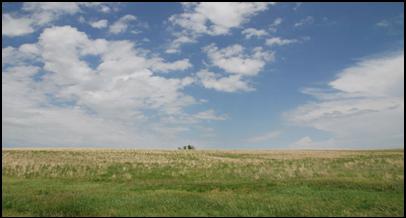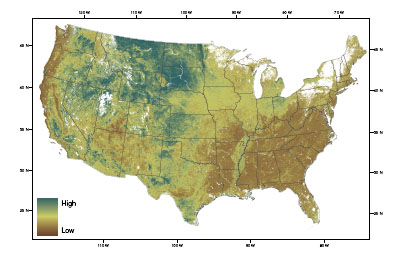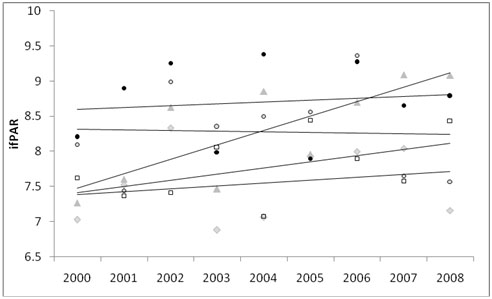College of Liberal Arts & Sciences
Remote Sensing of Ecosystem Dynamics and Land Use

Land Use and Interannual Variability: Remote sensing data enhance our ability to monitor and model the interactions between human activities and natural systems at landscape to regional-level scales. Of particular interest is the ability to study the interactions between fine-scale land use, broad-scale climate, and land-cover characteristics on the spatio-temporal dynamics of human-dominated and natural systems.
The local to global spatial distribution of land cover and land use has significant influences on climate, food security, and fundamental ecological processes. Similarly, the temporal dynamics such as such as the interannual variability of vegetation productivity have tremendous implications for local to global human and natural systems. Using time series of high-frequency remote sensing data such as MODIS or AVHRR data, we are able to map the changes in timing and magnitude of seasonal to decadal vegetation trends and variability. A fundamental component of our research includes examining the local to global factors influencing these changes such as climate, land use, vegetation types, and abiotic factors to determine the pre-disposing factors of interannual variability and the potential significance of interactions and potential feedbacks between natural processes and human activities.

Vegetation variability from 2000 to 2006 across the conterminous US as measured by MODIS 1km resolution data (Rowhani et al. 2008)
The productivity of terrestrial ecosystems can vary substantially from year to year. Based on continental coverage of Africa using MODIS data, Linderman et al. (2005) showed that the aggregate productivity of sub-Saharan Africa can differ by as much as 5% each year and that 1.6 million km2 of the continent underwent an annual change in productivity of at least 20% some time between 2000 and 2004. Climate is considered a primary factor influencing ecosystem variability. However, previous studies on inter-annual variability suggest human activities may have significant impacts on the underlying processes that influence these ecosystem dynamics. Serneels et al. (2007), for example, employed a multi-level regression analysis to examine the contributions of regional climate and various fine-scale factors such as land practices and management. We found that agricultural intensity and other human activities contributed significantly to differences in interannual variability among land units.
These year-to-year changes have significant ecological influences. For example, Rowhani et al. (2008) showed that interannual variability of energy availability had a significant effect on resident bird populations. Initial fine-scale analyses in Iowa suggest interactions between plot-level characteristics and climate are significant factors in the timing and integrated fPAR across landscapes. While agricultural systems did show a higher peak productivity, prairie systems tended to have higher annual fPAR overall and less variability from year-to-year. In addition, mixed effects multi-level models of climatic factors, land use, and soil characteristics suggest that the factors contributing to year-to-year differences in overall productivity are related not only to the broad-scale climate factors, but also plot-level specific characteristics. Ecological constraints vary significantly between land uses and interact with community-level characteristics.
 Five representative prairie plot nine-year integrated fPAR values and example random intercept and year coefficient trend lines.
Five representative prairie plot nine-year integrated fPAR values and example random intercept and year coefficient trend lines.
The figure shown above provides an example of random intercept and coefficient regressions in time-series analysis of climate and plot-level influences on land cover dynamics. Nearly 50% of the interannual variability is related to interactions between climate and community factors.
Further studies of the land-use specific ecological drivers and fine-scale management and plot-level interactions will provide a better understanding of the driving factors of vegetation dynamics across scales and improve regional estimates of historical and future impacts on human and natural system dynamics.

Interannual variability of integrated EVI from 2002 to 2005 (Linderman et al. 2005)
References
- Rowhani P, Lepczyk CA, Linderman MA, Pidgeon AM, Radeloff VC, Culbert PD, and Lambin EF. Variability in energy influences avian distribution patterns across the USA. Ecosystems, 11(6): 854-867 June 2008.
- Lupo F, Linderman M, Vanacker V, Bartholomé E., And Lambin EF. Categorization of land-cover change processes based on phenological indicators extracted from time series of vegetation index Data. International Journal of Remote Sensing 28 (11): 2469-2483 June 2007.
- Serneels S, Linderman M, and Lambin EF. A multilevel analysis of the impact of land use on interannual land-cover change in East Africa. Ecosystems 10 (3): 402-418 April 2007.
- Lambin EF and Linderman M. Time series of remote sensing data for land change science. IEEE Transactions on Geoscience and Remote Sensing 44 (7): 1926 – 1928 July 2006.
- Linderman M, Rowhani P, Benz D, Serneels S, Lambin EF. Land-cover change and vegetation dynamics across Africa. Journal of Geophysical Research-Atmospheres 110 (D12): Art. No. D12104 Jun 17 2005